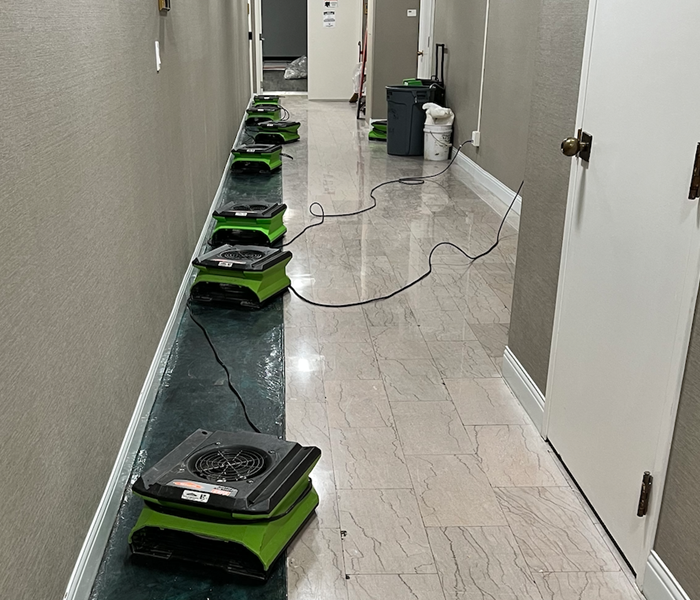Know the Common Causes of Water Damage
11/14/2022 (Permalink)
Be Rain Ready
Living in Northern Ohio comes with the consequence of dealing with some of the most unpredictable weather patterns possible. We’ve all experienced the weeks where the weather is beautiful on Monday, pouring rain on Tuesday, then a blizzard on Wednesday. It’s important to be prepared for anything, especially the risk of water damage.
Being rain ready means that you should do things like check your roof for leaks, clearing your gutters of leaves and other debris so water can flow through them properly, and most importantly, making sure you’re ready to call SERVPRO of SE Summit County/Lake Township if anything goes wrong!
Causes of Water Damage
Water damage can happen whenever any amount of excess water collects in an area where it shouldn't. Many different factors can cause a collection of excess water and contribute to water damage.
If you are aware of the potential causes, you will be able to prepare and avoid leaks and floods. You will also be able to spot a problem as soon as it happens, and stop it before it causes additional damages.
The more quickly you notice the problem, the less work the water extraction and water damage restoration company will have to fix.
Causes of water damage include:
- Bursting or leaking pipes
- Issues with the plumbing system
- Hot water tanks
- Buildup in water-prone areas such as basement, attics, or other crawl spaces
- Faulty or malfunctioning household appliances
- HVAC issues
- Natural disasters and other weather-related water problems
No matter what the issue, you can call the experts at SERVPRO of Southeast Summit County and Lake Township to make it look "Like it never even happened."
How to Handle Leaky Pipes
It’s no secret that water damage is bad, not only can it cost a lot of money to fix if left unmitigated, but it can also lead to the growth of molds that can cause health effects. Mold needs water to grow, and it can grow quickly if things like leaks and water damage aren’t fixed quickly. That’s why it’s important to check for leaky pipes, and if you find one, it’s important to know how to fix it.
- The first thing you can do when fixing a leaky pipe is see where the water is coming from. If it’s coming from a loose coupling nut (the thing that holds pipes together), then it’s pretty easy to grab a wrench and tighten the nut, fixing your leak.
- If the leak is caused by a crack in the pipe itself, you will need to use either plumber’s tape, self-fusing silicone tape, or epoxy putty to fix it. These are easy to apply, just make sure the water is turned off then wrap the pipe if you’re using tape, or just apply putty to the pipe and give it some time to dry.
After fixing the pipe, make sure to clean up any standing water, and check back every day, or every few days to make sure there is no more water or leaking.
If you’ve experienced water damage or mold growth, call SERVPRO of SE Summit/Lake Township and our professionals with take care of everything.
Kitchen Water Damage Causes
No area of the home is completely immune to water damage; it can occur anywhere. The kitchen is particularly at risk for water damage due to the amount of water required for everyday tasks, such as washing dishes and preparing meals. Because water damage can have devastating consequences, it is beneficial to understand which areas of the kitchen are at the greatest risk for leaks.
- The Refrigerator and Ice Maker
During the summer, a cold, refreshing glass of water makes all the difference on a hot day. The refrigerator and ice maker make this possible by producing ice, but ice makers seem to frequently generate leaks. From improper installation to parts becoming damaged or worn-out, ice makers can leak for a handful of reasons. Puddles of water on the floor beneath the fridge and ice maker are usually good indicators that there is a leak. To prevent water damage, be on the lookout for water on the floor and make sure that the refrigerator and ice maker undergo regular maintenance and inspection.
- The Dishwasher
We load and unload our dishwashers in order to clean silverware, plates, and cups on a daily basis, sometimes even multiple times a day. The amount of water required to carry out this task is tremendous and combined with the fact that the dishwasher is used so frequently, dishwashers pose a significant threat to the kitchen. Dishwashers can create water damage by leaking or flooding as a result of using the wrong type of detergent, a bent or broken dishwasher door latch, or the dishwasher overfilling with water. Watch out for puddles of water underneath the dishwasher, as it may be the sign of a leak.
- The Sink
The sink is probably the first kitchen appliance that comes to mind when you think of water usage. We use the kitchen sink to fill up a cup of water, wash our hands, and wash dishes, among many other tasks. Water damage can occur when parts of the sink become corroded or when the drain or faucet leaks. About every 6 months, it is beneficial to take a look at the pipes beneath the sink and check for leaks as well as damaged sink parts in order to prevent water damage coming from the sink.
Because of the often costly and devastating effects of water damage, such as structural damage and mold and mildew growth, it is important to do everything in your power to avoid water damage. However, if you do experience water damage in your kitchen, don’t worry. Call SERVPRO of Southeast Summit/Lake Township today at 330-578-7617. For more information about our water damage services, click here.






 24/7 Emergency Service
24/7 Emergency Service
